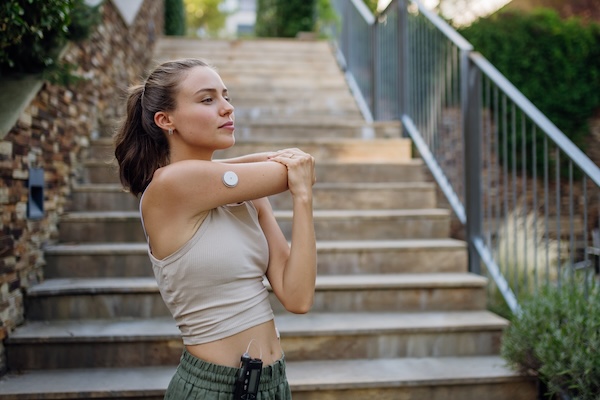 We at Biohackr Health are fans of knowing your blood sugar. We believe it may be a root cause of heart disease, inflammation, dementia, and of course diabetes. We carry CGMs (continuous glucose monitors) at our clinic. This tiny device which you wear for two weeks gives you real time blood sugar measurements.
We at Biohackr Health are fans of knowing your blood sugar. We believe it may be a root cause of heart disease, inflammation, dementia, and of course diabetes. We carry CGMs (continuous glucose monitors) at our clinic. This tiny device which you wear for two weeks gives you real time blood sugar measurements.
As with all new technology, continuous monitoring gives a tsunami of information. You are not doing this to treat each number individually. You are studying this to learn about YOUR pattern. What foods cause your blood sugar to spike? How high? Does modifying things change your blood sugar response? (ie: eating only half a bagel, not a full bagel, or eating a bagel with protein or fats). Does walking after eating help? Are you doing any of our other treatments which may help like NAD or our glucose control probiotic?
- Blood sugar spikes after eating.
- Hyperglycemia after eating is when plasma glucose goes above 140 mg/dl. Most meals peak below 140. (Pre diabetics can go up to 180. Those with diabetes frequently exceed 180 mg/dl)
- This tends to happen 1-2 hours after eating in those without diabetes and return to baseline around 2-3 hours after eating.
- There is fluctuation in blood glucose.
- Diet is important. Those with high carb/low fat diet had a bigger spike than those with low carb / high fat diet (a better, flatter curve and later nadir in glucose level is seen in those with a low carb diet.)
- Glycemic Index lets you know the foods with a higher effect on blood sugar levels. Higher glycemic index foods tend to cause higher glucose responses of short duration. This has been associated with metabolic syndrome – abdominal obesity, high blood pressure, high triglycerides, low HDL cholesterol and is associated with higher risk of heart disease and type 2 Diabetes.
- Microbiome is important. High fiber and prebiotics improve glucose metabolism. High greater quantity of veggies helps.
- Artificial sweeteners affect the microbiome adversely and have been found to increase calorie consumption and weight gain.
- Timing of meals is important. One study looked at eating and 8 am, 8pm, and midnight. Even with eating the same meal, glucose levels remained high and for longer when eating in the evening. This suggests that insulin sensitivity is tied to circadian rhythms.
- The shape of the glucose curve is as important as the height. In healthy individuals, the glucose curve is biphasic, with two spikes: one 30-60 min out, and another 90-120 minutes after the meal. In those who are insulin resistant, they tend to have one spike, “monophasic.”
How can Biohackr Health help?
- Know where you are starting from by doing our insulin panel, which includes HbA1c.
- We have CGM monitors. Try one out for two weeks to see where you are at.
- Lose weight. If you have been fighting the same 10 (or 40) pounds, see our page on weight loss solutions.
- Use our probiotic. It is private labeled, high quality (NSF third party certified) with strands of bacteria studied to help improve glucose metabolism.
- NAD may also help. We have a our NAD powder supplement which has been shown to increase NAD levels in the body.
